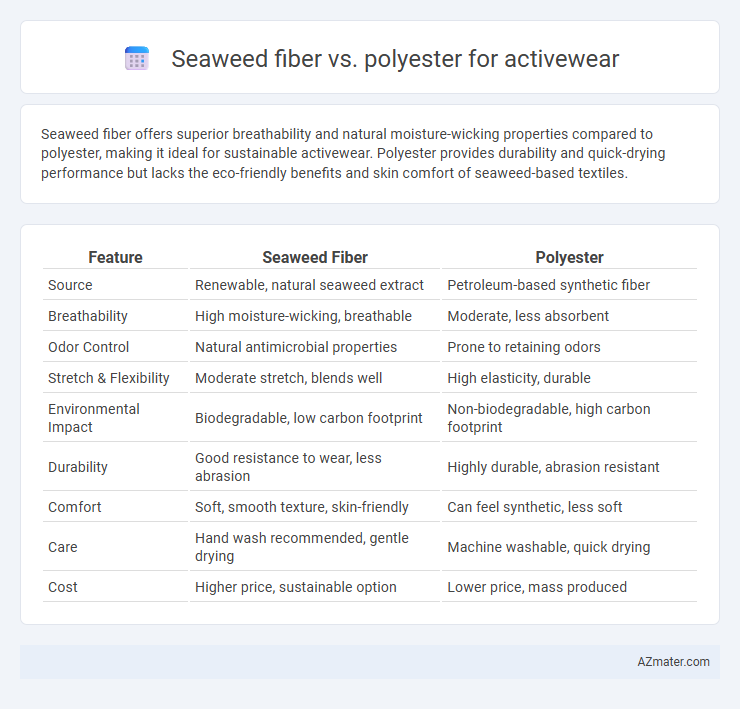Seaweed fiber offers superior breathability and natural moisture-wicking properties compared to polyester, making it ideal for sustainable activewear. Polyester provides durability and quick-drying performance but lacks the eco-friendly benefits and skin comfort of seaweed-based textiles.
Table of Comparison
| Feature | Seaweed Fiber | Polyester |
|---|---|---|
| Source | Renewable, natural seaweed extract | Petroleum-based synthetic fiber |
| Breathability | High moisture-wicking, breathable | Moderate, less absorbent |
| Odor Control | Natural antimicrobial properties | Prone to retaining odors |
| Stretch & Flexibility | Moderate stretch, blends well | High elasticity, durable |
| Environmental Impact | Biodegradable, low carbon footprint | Non-biodegradable, high carbon footprint |
| Durability | Good resistance to wear, less abrasion | Highly durable, abrasion resistant |
| Comfort | Soft, smooth texture, skin-friendly | Can feel synthetic, less soft |
| Care | Hand wash recommended, gentle drying | Machine washable, quick drying |
| Cost | Higher price, sustainable option | Lower price, mass produced |
Introduction to Seaweed Fiber and Polyester in Activewear
Seaweed fiber in activewear offers a sustainable and biodegradable alternative to synthetic materials, providing natural moisture-wicking and antibacterial properties. Polyester, a widely used synthetic fiber, excels in durability, stretch, and moisture management but is derived from petrochemicals and contributes to microplastic pollution. Comparing performance and environmental impact, seaweed fiber presents an eco-friendly innovation, while polyester remains the industry standard for high-performance activewear.
Environmental Impact: Seaweed Fiber vs Polyester
Seaweed fiber is a sustainable alternative to polyester in activewear, offering biodegradability and reduced microplastic pollution. Unlike polyester, which is derived from non-renewable petroleum and contributes significantly to carbon emissions during production and disposal, seaweed fiber is renewable and absorbs CO2 during growth. The adoption of seaweed fiber can lower the environmental footprint of activewear by minimizing synthetic waste and supporting ocean ecosystem health.
Moisture-Wicking and Breathability Comparison
Seaweed fiber outperforms polyester in moisture-wicking by naturally absorbing and releasing sweat, keeping activewear dry and comfortable during intense workouts. Its breathable structure allows superior airflow compared to the synthetic polyester, which tends to trap heat and moisture against the skin. This makes seaweed fiber an eco-friendly, performance-enhancing alternative for moisture management and ventilation in activewear fabrics.
Comfort and Skin Sensitivity Factors
Seaweed fiber offers superior breathability and natural moisture-wicking properties compared to polyester, making it ideal for activewear designed for comfort during intense workouts. Its hypoallergenic nature reduces the risk of skin irritation and allergies, benefiting individuals with sensitive skin. Polyester, while durable and quick-drying, often traps heat and moisture, which can lead to discomfort and exacerbate skin sensitivity issues.
Durability and Longevity in Activewear
Seaweed fiber in activewear offers moderate durability with natural resistance to wear but tends to degrade faster than polyester when exposed to frequent washing and intense physical activity. Polyester excels in longevity due to its synthetic composition, maintaining shape and strength over numerous wash cycles and high-impact use. For long-term activewear durability, polyester remains the preferred choice, though seaweed fiber appeals to eco-conscious consumers prioritizing sustainable materials.
Performance in High-Intensity Workouts
Seaweed fiber offers superior moisture-wicking and antimicrobial properties compared to polyester, making it ideal for high-intensity workouts. Its natural breathability enhances comfort by regulating body temperature and reducing odor buildup during intense exercise. Polyester, while durable and quick-drying, often traps heat and moisture, which can lead to discomfort and skin irritation during prolonged physical activity.
Antimicrobial and Odor-Control Properties
Seaweed fiber offers natural antimicrobial properties due to its inherent polysaccharides like alginate, which inhibit bacterial growth and reduce odor buildup in activewear. Polyester, while durable and moisture-wicking, often requires chemical treatments to achieve similar antimicrobial and odor-control effects, posing potential environmental concerns. Seaweed fiber's biodegradable nature combined with its effective odor control makes it a sustainable alternative to conventional polyester fabrics in performance apparel.
Sustainability and Biodegradability Analysis
Seaweed fiber, derived from natural algae, offers superior sustainability compared to polyester due to its renewable sourcing and minimal environmental impact during production. Unlike polyester, a petroleum-based synthetic fabric that contributes significantly to microplastic pollution and requires extensive energy consumption, seaweed fiber is fully biodegradable, breaking down without releasing harmful residues. The biodegradability of seaweed fiber supports circular fashion by reducing landfill waste, whereas polyester's slow degradation exacerbates long-term environmental pollution.
Cost and Market Availability
Seaweed fiber activewear tends to have a higher production cost due to its sustainable sourcing and limited large-scale manufacturing, making it generally more expensive than polyester. Polyester, derived from petroleum, benefits from mass production processes that drive down costs and ensure widespread availability in global markets. Market availability for seaweed fiber remains niche and emerging, while polyester dominates activewear due to established supply chains and affordability.
Future Trends in Activewear Fabric Innovation
Seaweed fiber is gaining traction as a sustainable alternative to polyester in activewear due to its natural biodegradability and skin-soothing properties, addressing rising consumer demand for eco-friendly fabrics. Innovations in seaweed fiber production are enhancing moisture-wicking capabilities and durability, making it more competitive with the synthetic resilience and stretch of polyester. Future trends indicate a growing blend of seaweed fiber and recycled polyester to balance performance, environmental impact, and comfort in activewear textiles.

Infographic: Seaweed fiber vs Polyester for Activewear
 azmater.com
azmater.com